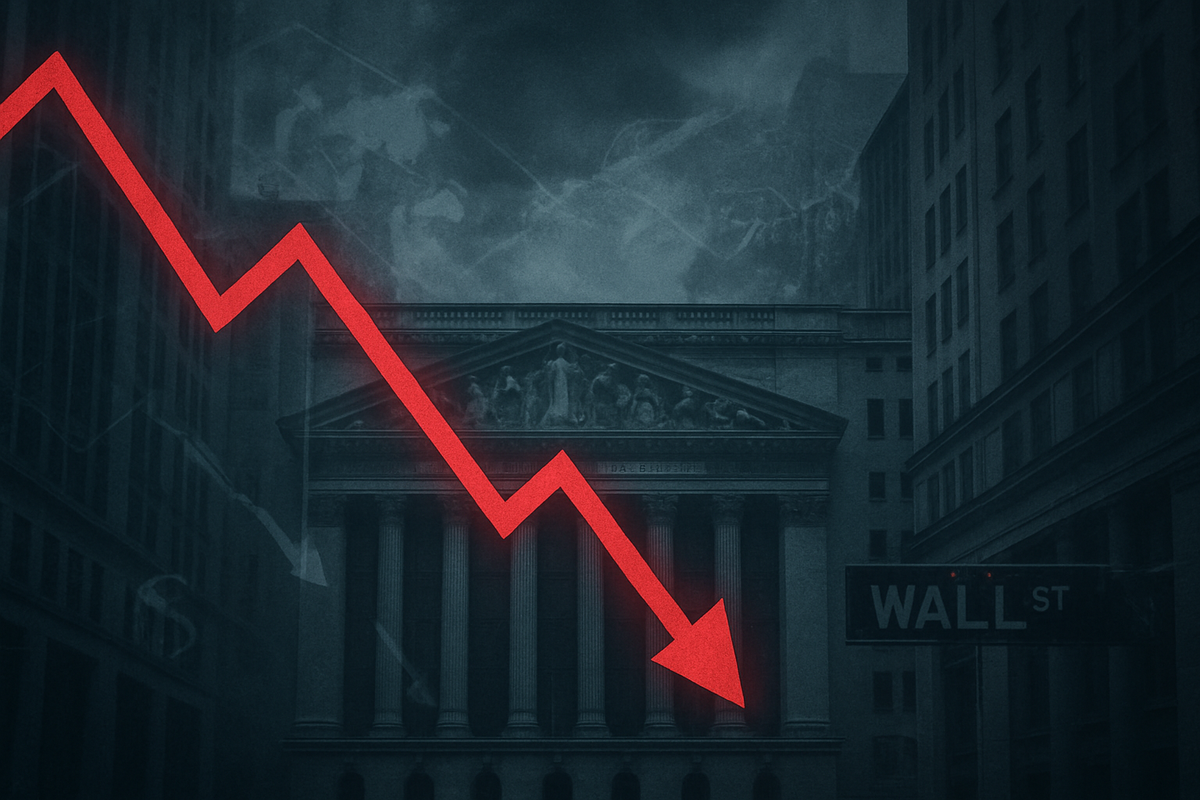
Wall Street experienced a seismic shock in April 2025, with a dramatic sell-off that saw the Dow Jones Industrial Average (DJIA) plummet by over 4,000 points in just two days. This unprecedented market downturn, triggered by aggressive new tariff policies from the U.S. administration, sent shockwaves across global financial markets, wiping out trillions in investor wealth. As of November 13, 2025, the repercussions of this severe correction continue to influence market sentiment, fostering an environment of heightened volatility and uncertainty that has left investors grappling with persistent economic anxieties.
The "Liberation Day" tariffs, as they were dubbed, ignited widespread panic selling, pushing major indices like the S&P 500 and Nasdaq Composite into bear market territory at a speed rarely seen in financial history. While daily market fluctuations continue to capture headlines, the sheer magnitude and contributing factors of the April crash remain a critical reference point for understanding the current cautious mood on Wall Street. This article delves into the specifics of that pivotal event, its immediate aftermath, and its enduring implications for public companies and the broader global economy as we navigate the remainder of 2025.
The Unfolding of a Historic Decline: April 2025's Market Meltdown
The financial storm began brewing on April 2, 2025, when the U.S. President, in his second term, announced sweeping tariff policies targeting nearly all sectors of the American economy. This declaration, intended to promote protectionism, instead ignited a global market panic that intensified dramatically over the following days. On April 3, the Dow Jones Industrial Average (DJIA) (NYSE: ^DJIA) plunged by an staggering 1,679 points, a 3.98% decline. The situation worsened on April 4, with the DJIA shedding an additional 2,231 points, or 5.5%, bringing its two-day loss to over 4,000 points – a staggering 9.48% and the first time the index had dropped over 1,500 points consecutively.
The contagion spread rapidly across other major indices. The S&P 500 (NYSE: ^GSPC) suffered a 4.84% loss on April 3, followed by a 5.97% drop on April 4, marking its worst two-day performance in history and pushing it into a bear market with a 10% decline. Similarly, the Nasdaq Composite (NASDAQ: ^IXIC) lost 1,600 points on April 3, its steepest sell-off since the early days of the COVID-19 pandemic, and another 5.8% on April 4, also entering bear market territory with an overall 11% two-day loss. The Russell 2000 (NYSE: ^RUT), representing small-cap stocks, led the initial declines on April 3, falling 6.59% and immediately signaling a bear market for smaller enterprises.
The primary catalyst for this historic downturn was the escalation of trade tensions. The U.S. President's "Liberation Day" tariffs were met with swift retaliation from China on April 4, which imposed a 34% tariff on American imports. This tit-for-tat exchange not only deepened the existing trade war with China but also sparked new trade conflicts with key allies like Canada and Mexico, fueling fears of a global recession. Initial market sentiment was characterized by "widespread panic selling," with investors desperately offloading assets. The Chicago Board Options Exchange's VIX benchmark (CBOE: ^VIX), often referred to as "Wall Street's fear gauge," surged 15 points to close at 45.31, its highest level since the 2020 stock market crash, underscoring the extreme fear and uncertainty permeating the market.
Initially, investors sought refuge in bonds, causing yields to fall. However, this flight to safety was short-lived, quickly reversing into a widespread bond market sell-off as confidence in U.S. fiscal policy waned, causing bond yields to surge. The sheer scale of the losses was staggering; within the first two days of April, over $6.6 trillion in market value was erased, marking the largest two-day loss in financial history. This event underscored the fragility of interconnected global markets in the face of aggressive protectionist policies and geopolitical tensions.
Corporate Fortunes in Flux: Winners and Losers in a Tariff-Driven Landscape
The sweeping tariff policies enacted in April 2025, and the subsequent global retaliations, dramatically reshaped the competitive landscape for numerous public companies and entire sectors. The immediate fallout saw significant pressure on companies reliant on global supply chains and international trade, while a few niche domestic industries experienced an unexpected, albeit often temporary, boost.
Losers were predominantly found in sectors heavily exposed to international trade, particularly those with complex global supply chains. Technology companies like Apple (NASDAQ: AAPL) and Microsoft (NASDAQ: MSFT), which assemble products using components sourced worldwide and sell into global markets, faced increased production costs due to import tariffs and potential reduced demand in retaliating countries. Similarly, manufacturing giants such as Boeing (NYSE: BA) and Caterpillar (NYSE: CAT), whose revenues are heavily tied to exports and who rely on imported raw materials, saw their profit margins squeezed and international sales hampered by punitive tariffs. The automotive industry, with its intricate cross-border production networks, also suffered, as tariffs on imported parts drove up costs for companies like General Motors (NYSE: GM) and Ford (NYSE: F), while retaliatory tariffs made exporting finished vehicles more expensive.
The agricultural sector was among the hardest hit, as retaliatory tariffs from countries like China severely impacted exports of key commodities. American farmers, and by extension, companies like Archer-Daniels-Midland (NYSE: ADM) and Bunge (NYSE: BG), faced significant challenges as traditional markets for soybeans, corn, and other agricultural products became less accessible or prohibitively expensive due to tariffs. Retailers with significant import exposure, such as Walmart (NYSE: WMT) and Target (NYSE: TGT), also grappled with higher sourcing costs, which they either had to absorb, impacting profitability, or pass on to consumers, potentially dampening sales.
Conversely, the "Liberation Day" tariffs aimed to bolster domestic production, creating potential, albeit often limited, winners. Certain domestic manufacturing firms in protected industries, particularly those with minimal reliance on imported inputs, saw a temporary competitive advantage as foreign goods became more expensive. Companies focused on reshoring initiatives or those with predominantly local supply chains might have found opportunities. However, the overall market contraction and the uncertainty created by the trade wars largely overshadowed these isolated gains, leading to a net negative impact across most public companies as the global economy tightened.
A Broader Canvas: The Wider Significance of Protectionism and Global Trade Disruption
The April 2025 sell-off was not merely a market correction; it was a stark indicator of the profound and far-reaching consequences of aggressive protectionist policies and escalating global trade wars. This event fits squarely into a broader trend of economic nationalism challenging the established multilateral trading system, with ripple effects that continue to reshape global industry, international relations, and consumer behavior.
The most immediate and pervasive ripple effect has been on global supply chains. Companies, already grappling with post-pandemic vulnerabilities, faced increased costs and immense pressure to reconfigure their sourcing and distribution strategies. Tariffs forced businesses to either absorb higher input costs or find alternative, often more expensive, suppliers, leading to increased operational complexity and reduced efficiency. This environment has encouraged some companies to consider reshoring or nearshoring production, prioritizing resilience and political stability over cost optimization, fundamentally altering decades of globalization trends.
Geopolitically, the trade war has severely strained international relations, fostering an environment of distrust and economic confrontation. The tit-for-tat tariff exchanges between major economic powers like the U.S. and China, and the emergence of new trade disputes with traditional allies, have undermined diplomatic ties and weakened international cooperation on a range of global issues. This climate has also challenged the efficacy of international institutions like the World Trade Organization (WTO), as nations increasingly bypass established frameworks in favor of unilateral actions, risking a fragmentation of the global economy into competing trade blocs.
Historically, major trade wars have consistently led to detrimental long-term outcomes. The Smoot-Hawley Tariff Act of 1930, for instance, which raised tariffs on thousands of U.S. imports, is widely credited with exacerbating the Great Depression and triggering widespread retaliatory tariffs that caused global trade to plummet by over 60%. More recently, the U.S.-China trade war initiated in 2018 demonstrated how such conflicts disrupt supply chains, slow economic growth, and reduce investment and consumer spending globally. The April 2025 events serve as a potent reminder that the overall costs of protectionist conflicts typically far outweigh any perceived short-term domestic benefits, leading to prolonged economic stagnation and international instability.
Navigating the Aftermath: What Comes Next for Markets and Businesses
The fallout from the April 2025 market sell-off and the ongoing global trade war has ushered in an era of heightened uncertainty, dictating both short-term market behavior and long-term strategic pivots for businesses and investors. As of November 13, 2025, the market remains susceptible to volatility, with the prospect of continued trade tensions casting a long shadow over economic forecasts.
In the short term, investors should anticipate sustained market volatility. New tariff announcements or retaliatory measures can trigger swift and dramatic swings in equity prices, keeping the VIX "fear index" elevated. This environment necessitates a cautious approach, with a focus on diversification across asset classes and geographies to mitigate risk. The potential for a global recession remains a significant concern, as tariffs continue to raise costs for businesses and consumers, compress profit margins, and reduce overall demand. Central banks face the delicate balancing act of controlling inflation—driven by higher import costs—while simultaneously attempting to stimulate economic growth, making monetary policy responses complex and often unpredictable. Governments, through fiscal policy, may lean towards increased spending or tax cuts to counteract economic slowdowns, but the inflationary pressures could constrain their options.
Looking further ahead, the long-term landscape will likely be defined by corporate adaptation and strategic reorientation. Businesses are already actively diversifying their supply chains, moving away from over-reliance on single countries impacted by tariffs. This "China+1" or "China+2" strategy involves seeking alternative suppliers in regions with more favorable trade agreements or lower tariff risks. Localization of production, increased investment in automation, and advanced supply chain analytics are becoming crucial for enhancing resilience and managing costs. Companies will also need to engage more proactively in government relations and advocacy to navigate evolving trade policies and seek exemptions.
For investors, the current environment presents both challenges and potential opportunities. While panic selling should be avoided, a focus on fundamentally strong companies that are either less exposed to trade wars or have demonstrated robust adaptation strategies will be key. Defensive sectors like consumer staples and utilities may offer relative stability. Dollar-cost averaging and a long-term perspective remain vital strategies to navigate the ongoing volatility. The ultimate trajectory will depend on whether trade tensions de-escalate through diplomatic efforts or continue to escalate, potentially leading to a more fragmented global economy and prolonged periods of slower growth.
The Enduring Impact: A Market in Transition
The April 2025 Wall Street sell-off, sparked by an aggressive wave of protectionist tariffs and subsequent global trade retaliation, stands as a pivotal event that continues to shape the financial markets as of November 13, 2025. The immediate aftermath saw trillions erased from market capitalization and major indices plunging into bear market territory, fundamentally altering investor sentiment and corporate strategies. Key takeaways from this period underscore the profound interconnectedness of global economies and the severe repercussions of trade disputes on market stability, supply chain integrity, and international relations.
Moving forward, the market is in a transitional phase, characterized by persistent volatility and a recalibration of global trade dynamics. While daily fluctuations will continue, the underlying anxieties stemming from trade wars, inflationary pressures, and the threat of recession will likely define the investment climate for the foreseeable future. Businesses are being forced to fundamentally rethink their global footprints, prioritizing resilience and diversification over pure cost efficiency, leading to significant shifts in manufacturing and sourcing strategies.
The lasting impact of this event will likely be a more fragmented, yet potentially more resilient, global economy. Nations and corporations are increasingly focused on national security and self-sufficiency in critical sectors, which could lead to a less efficient but more robust global supply system. Investors should remain vigilant, closely monitoring geopolitical developments, central bank policy shifts, and corporate earnings reports for signs of adaptation or continued distress. A diversified portfolio, a long-term investment horizon, and a keen eye on companies demonstrating agility in navigating the new trade landscape will be paramount in the coming months.
This content is intended for informational purposes only and is not financial advice





